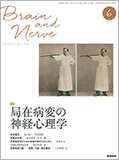Japanese
English
- 有料閲覧
- Abstract 文献概要
- 1ページ目 Look Inside
- 参考文献 Reference
エピソード記憶の障害を主徴とする純粋健忘は,大脳辺縁系の代表的な記憶や情動の回路であるパペッツの回路やヤコブレフの回路を形成する諸部位の損傷により出現してくる。今回は脳血管障害を対象として純粋健忘の責任病巣について論じることにした。主として,視床性記憶障害と海馬性記憶障害の臨床例を呈示し,さらに,retrosplenial amnesiaや脳弓性健忘について解説した。なお,扁桃体損傷や尾状核損傷により純粋健忘を呈した臨床例についても紹介した。
Abstract
Pure amnesia (amnesic syndrome) is an organic brain syndrome characterized by impairment in episodic memory, with either an anterograde or sometimes retrograde loss of memories. Although episodic memory is impaired, semantic memory, immediate memory, and procedural memory are preserved. The Papez circuit is a network of nerve fibers and nerve centers that starts and ends in the hippocampus travelling by way of the fornix, mammillary bodies, anterior thalamic nuclei, cingulate gyrus, and parahippocampal gyrus. A lesion restricted to this circuit often produces pure amnesia. Regions concerned with the Yakovlev circuit also have an important role in memory. Clinical cases of pure amnesia caused by cerebrovascular disease presented following brain imaging and resulted from various different lesions. The cases identified were predominantly thalamic amnesia and hippocampal amnesia. Thalamic amnesia often resulted from an infarction in the territory of the thalamotuberal artery and paramedian thalamic artery although thalamic hemorrhage in medial portion of thalamus also produced pure amnesia. Hippocampal amnesia usually occurred following an infarction in the temporal branches of posterior cerebral artery. Cases of retrosplenial amnesia caused by subcortical hematoma and infarction in the retrosplenial region are also described. In addition, cases of pure amnesia resulting from an infarction in the fornix, mammillary body hemorrhage, and caudate hemorrhage are also shown.

Copyright © 2017, Igaku-Shoin Ltd. All rights reserved.


